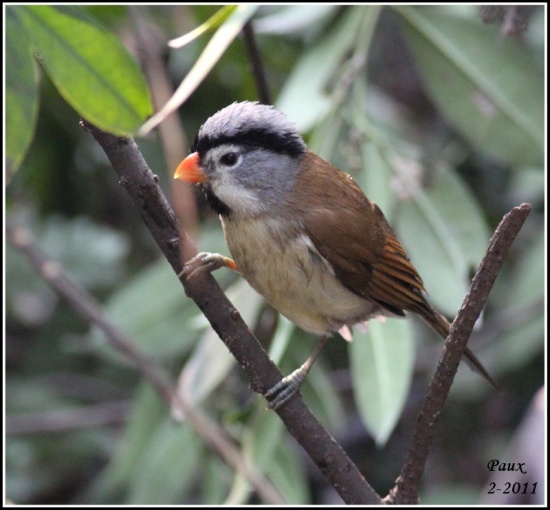Alternative name: Grey-headed Crowtit
- Psittiparus gularis
Identification
15.5 - 18.5cm (6-7¼ in). A parrotbill with a distinctive head pattern:
- White lores , eyering and moustache
- Black lateral crownstripe and throat
- Grey crown and ear-coverts
- Rufous-brown above
- White below, tinged buffy on breast and flanks
- Orange-yellow deep bill
Sexes similar, juveniles are warmer above, have weaker black on throat and less pure grey crown.
Similar species
Superficially similar to Nepal Fulvetta, but note the completely different bill and the more contrasting plumage of this species.
Distribution
Found from north India (Sikkim) east to Bhutan, northeast India, Burma, north Thailand, south, central and east China, Laos and Vietnam.
Widespread but generally uncommon.
Taxonomy
Black-headed Parrotbill was formerly considered a subspecies of this species.
Formerly placed in the genus Paradoxornis.
Subspecies
Six subspecies recognized:
- P. g. gularis from north India (Sikkim) east along the Himalayas over Bhutan to western Arunachal Pradesh
- P. g. transfluvialis in most of northeast India, north and east Burma, extreme south China (Yunnan) and northwest Thailand. Sometimes merged with the nominate.
- P. g. rasus in the southern Chin Hills in Burma
- P. g. laotianus in extreme east Burma, south China (Yunnan, Guangxi), eastern parts of northwest Thailand, Laos and Vietnam. Merged by some authors with fokiensis.
- P. g. fokiensis in central and east China (Sichuan to Jiangxi, Anhui, Zheijang, Fujian, Guangxi and Guangdong)
- P. g. hainanus on Hainan, China
Habitat
Broadleaf evergreen forest, scrub near forest, secondary growth, bamboo and grass and scrub in pine forest. Mostly found at 610 - 2100m, in Thailand at 1200 - 1830, in China at 450 - 1850m.
Behaviour
Diet
Feeds on vegetable matter including buds, seeds and chestnuts. Also seen taking insects and larvae. Usually seen in groups of 6 to 8 birds, sometimes much more. Regularly in bird waves. Often high up in treetops, behaving similar to a tit.
Breeding
Breeding season February to July. The nest is a nice, neat cup-shaped structure made of grasses, strips of bamboo leaves, leaf skeletons and similar material. It's placed 2 - 3m above the ground in a sapling or a forked branch of a medium-sized tree. Lays 2- 4 eggs.
Movements
Resident species.
References
- Clements, J. F., T. S. Schulenberg, M. J. Iliff, D. Roberson, T. A. Fredericks, B. L. Sullivan, and C. L. Wood. 2015. The eBird/Clements checklist of birds of the world: v2015, with updates to August 2015. Downloaded from http://www.birds.cornell.edu/clementschecklist/download/
- Del Hoyo, J, A Elliott, and D Christie, eds. 2007. Handbook of the Birds of the World. Volume 12: Picathartes to Tits and Chickadees. Barcelona: Lynx Edicions. ISBN 978-8496553422
- Rasmussen, PC and JC Anderton. 2005. Birds of South Asia: The Ripley Guide. Barcelona: Lynx Edicions. ISBN 978-8487334672
Recommended Citation
- BirdForum Opus contributors. (2024) Grey-headed Parrotbill. In: BirdForum, the forum for wild birds and birding. Retrieved 27 July 2024 from https://www.birdforum.net/opus/Grey-headed_Parrotbill




